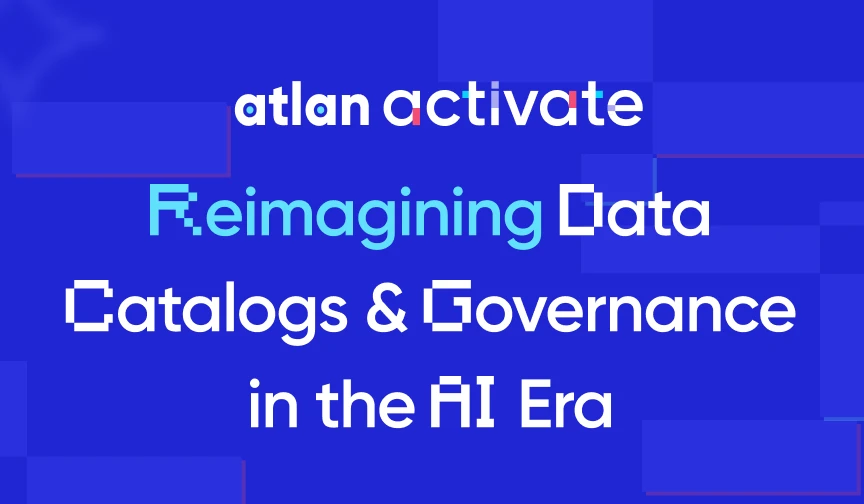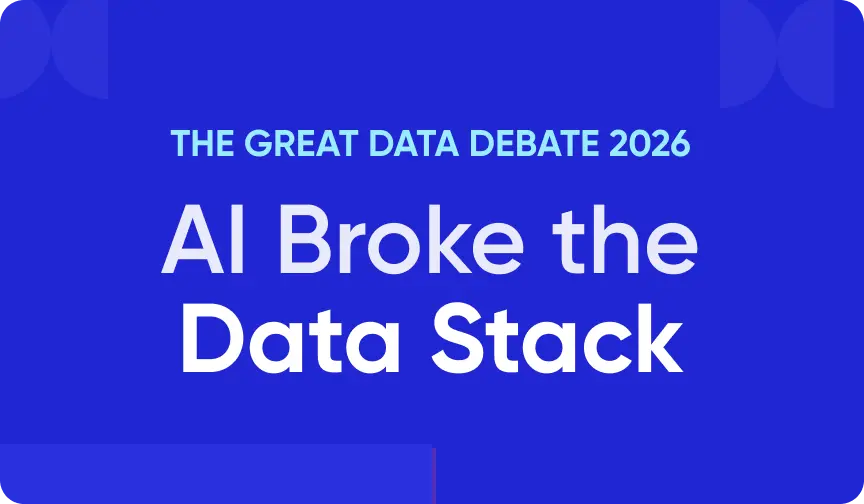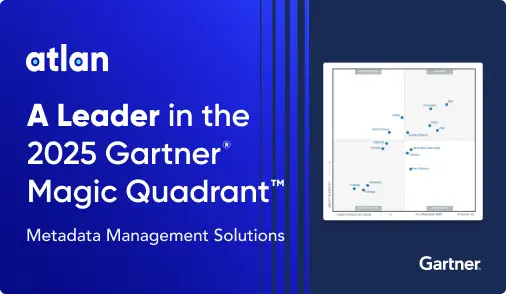Data Access Governance Tools: What Evaluation Qualities & Criteria Matter in 2025

Last Updated on: May 02nd, 2025 | 12 min read
Unlock Your Data's Potential With Atlan

Data access governance tools help enterprises manage who has access to what data, and under what conditions, balancing security, compliance, and data enablement. This prevents unauthorized access, helps meet legal obligations, and ensures teams can use data responsibly without delay.
As data becomes more distributed and dynamic, traditional top-down models, which were designed to restrict, aren’t enough. Modern data access governance tools offer a flexible, metadata-driven approach that enables real-time policy updates while ensuring auditability and compliance alignment.
In this article, we’ll explore:
- The core capabilities of modern data access governance tools
- Evaluation criteria, metrics, and scoring frameworks
- Common pitfalls to avoid
- How Atlan helps scale access governance across modern data stacks
Table of contents
Permalink to “Table of contents”- How to pick the right data access governance tool: 5 product qualities to consider
- How to evaluate data access governance tools effectively for your unique use cases
- What are some of the most common pitfalls when choosing a data access governance tool?
- How does Atlan approach data access governance?
- The right data access governance tools evolve with your teams
- Data access governance tools: Frequently asked questions (FAQs)
- Data access governance tools: Related reads
How to pick the right data access governance tool: 5 product qualities to consider
Permalink to “How to pick the right data access governance tool: 5 product qualities to consider”The ideal data access governance tool should make it easy to control access while supporting agility, collaboration, and compliance at scale. Many conventional approaches to data access governance were designed to lock data down. By focusing on restrictions over usability, they often created delays, workarounds, and frustration across teams.
The path forward in a world shaped by AI, cloud-native data stacks, and tightening regulations is to build for adaptability. This requires a shift from command-and-control to enablement, supporting live policy updates, secure collaboration, and real-time responses to changing data needs.
When evaluating solutions, here are the five essential product qualities to look for:
- A unified policy center for access governance
- Flexibility and ease of use in access policy setting
- Automation and AI to drive compliance at scale
- Embedded collaboration to power daily workflows
- Open-by-design to enable endless extensibility
Let’s break down each capability.
1. A unified policy center for access governance
Permalink to “1. A unified policy center for access governance”A unified policy center offers end-to-end visibility into how access is governed across your data estate. It centralizes access control policies, maps them to relevant data assets, and tracks their enforcement in real time. This prevents policy drift, reduces gaps, and allows governance teams to intervene before issues become risks.
Look for a data access governance tool that allows you to:
- Define, manage, and monitor access policies from a single interface
- Track how policies apply across domains, users, and systems
- Monitor policy overlaps, inconsistencies, or coverage gaps across your data estate
- Send alerts when assets fall out of compliance in real time
- Review, approve, and update access workflows from one place
2. Flexibility and ease of use in access policy setting
Permalink to “2. Flexibility and ease of use in access policy setting”Every organization has unique access patterns, hierarchies, and compliance requirements. The tool should offer enough flexibility to define policies based on business logic, not just static roles.
Whether you’re supporting an analyst in marketing or an engineer working on a machine learning pipeline, you should be able to tailor access without re-engineering your governance system every time something changes.
This means supporting:
- Access policies personalized for personas, purposes, data domains, or projects
- Governance by exception, where you add exceptions to your policies for every edge case
- Granular permissioning at the schema, table, column, or tag level
- No-code policy workflows to help you select policies, choose domains, and build approval workflows within minutes
- A discovery-friendly, visibility by default approach for non-sensitive data assets, allowing everyone to gain the context necessary to understand access requirements
3. Automation and AI to drive compliance at scale
Permalink to “3. Automation and AI to drive compliance at scale”Manually updating access rules or classifying sensitive data doesn’t scale. The tool should come with automation and AI capabilities that reduce manual effort and ensure continuous policy alignment.
For example, instead of individually reassigning access as team structures shift, you could use automation to bulk-update metadata and apply the right permissions across affected datasets.
Look for:
- AI-assisted policy creation to write policies and connect them to data in minutes
- Rule-based playbooks to auto-classify data assets and assign access tags, trigger access reviews, ownership changes, or metadata updates
- Bi-directional tag sync to automate compliance between the data governance tool and source systems
- Real-time alerts for violations, outliers, or non-compliant activity
4. Embedded collaboration to power daily workflows
Permalink to “4. Embedded collaboration to power daily workflows”Access governance should not depend on users switching platforms or raising IT tickets. The best tools bring governance actions—such as access requests, approvals, and policy updates—into the tools where data teams already work. That’s embedded collaboration.
Here’s what embedded collaboration would look like when using the right data access governance tool:
- Requesting access directly from BI tools like Tableau or Looker
- Approving or rejecting requests within Slack, Jira, or email
- Viewing access context (such as metadata, ownership, or sensitivity) via browser extensions embedded in Snowflake, dashboards, or catalogs
- Adding comments or notes for auditability without leaving the workflow
For example, if a user tries to access a restricted dataset in Snowflake, they should be able to see why it is restricted, who owns it, and how to request access without leaving their query editor.
This embedded, metadata-driven experience accelerates approvals, reduces dependency on IT or governance teams, and keeps data access aligned with daily operations. For compliance and governance leads, it also provides a clear, contextual record of how access decisions are made and enforced, while setting the stage for AI-readiness.
5. Open-by-design to enable endless extensibility
Permalink to “5. Open-by-design to enable endless extensibility”Your data access governance tool should be able to:
- Connect to cloud warehouses like Snowflake, BigQuery, and Redshift
- Integrate with identity providers (IdPs) for authentication and user mapping
- Interact with orchestration tools, data catalogs, and policy-as-code frameworks
More importantly, your access governance tool should be built for change, providing a flexible foundation for “current knowns and future unknowns” and driving endless extensibility.
This openness is critical to future-proofing your governance investments. As your data environment evolves, your access policies should travel with it.
So, look for a data access governance solution that lets you create an extensible self-service layer for managing data governance in a single platform. You can use its open APIs to build custom solutions tailored to your use cases.
How to evaluate data access governance tools effectively for your unique use cases
Permalink to “How to evaluate data access governance tools effectively for your unique use cases”The right data access governance tool should strike the right balance between security and usability. Use the following framework to assess capabilities:
- Run a proof-of-concept to test the tool against real access policies, across cloud and on-prem assets. Validate ease of policy setup, enforcement fidelity, and integration with IAM or data catalogs.
- Track key access governance metrics, such as:
- Access policy coverage: % of datasets governed by enforceable access policies
- Access request resolution time: Average time to grant or revoke access
- Audit coverage: % of access events captured and traceable
- Policy drift incidents: Frequency of manual overrides or misalignments
- False positive/negative rate: Quality of automated alerts and access suggestions
- Ask vendors the right questions, such as:
- How do policies adapt across cloud and on-premise systems?
- Can we create purpose-based access workflows?
- How is access policy conflict resolution handled?
- How do access logs support audit and compliance teams?
- Can the tool integrate with our identity providers and catalogs?
- Use a scoring matrix to compare vendors with attributes, such as purpose-based access workflows, policy automation, compliance reporting, extensibility, ease of use, and vendor support.
What are some of the most common pitfalls when choosing a data access governance tool?
Permalink to “What are some of the most common pitfalls when choosing a data access governance tool?”The most common pitfalls when evaluating data access governance tools include:
- Relying only on static role-based controls: These don’t reflect today’s dynamic access needs or contexts. Choose tools that integrate access control with actionable governance.
- Ignoring metadata and lineage context: Metadata context is essential for accurate governance, AI-readiness, and scalable compliance. So, the tool you choose should support access decisions by considering data sensitivity, lineage, and classification.
- Underestimating audit complexity: Ensure the tool supports detailed, future-proof logging and reporting across systems.
- Overcomplicating user experience: Overly technical setups alienate business users. Opt for no-code policy builders and clear workflows.
- Lack of integration with governance ecosystems: Your access controls should flow into your broader data governance stack—catalogs, quality tools, BI layers, and compliance systems. Pick tools that are built on an open architecture, supporting endless extensibility.
How does Atlan approach data access governance?
Permalink to “How does Atlan approach data access governance?”Atlan considers data democratization as the fundamental data governance objective, empowering everyone in the enterprise to access, understand, and use data for smarter business decisions.
“Imagine if a user could request access to a data asset as soon as they receive a link (like with Google Docs) and then the owner could approve or reject the request without leaving Slack.” - Atlan’s approach to data access governance
Atlan acts as a metadata control plane that unifies access governance across your ecosystem. For example:
- Contextual access rules can be defined using metadata attributes like tags, domains, or owners.
- Lineage-aware access ensures downstream data inherits upstream access policies.
- Policy-as-code integrations allow teams to manage access through versioned, auditable code bases
- Automation via playbooks leverages metadata patterns to auto-classify assets with rule-based workflows
This makes it easier for compliance teams to ensure consistent access without disrupting the daily workflows of data users.
How an online audio content leader improved access to Snowflake assets with Atlan
Permalink to “How an online audio content leader improved access to Snowflake assets with Atlan”An online audio content pioneer hosting thousands of podcasts, millions of songs, and on-demand programming for radio shows wanted to democratize its Snowflake data assets.
A growing challenge for this organization’s 12-member data engineering and architecture team was balancing data democratization with governance. As more users across the business became aware of Snowflake as a central data store, access requests surged—from highly technical analysts to less experienced business users with limited SQL skills.
The organization needed a scalable, context-rich way to guide users to the right data without overwhelming them or overburdening the engineering team. By using Atlan as a data access governance layer, the team created a structured, role-sensitive approach:
- When users request access to Snowflake, the team assesses their technical background through a set of standard questions.
- Based on the responses, users are guided to the most appropriate tool—often Atlan—for browsing, understanding, and working with data.
- Atlan provides these users with metadata context, saved queries, and documentation, allowing them to explore data confidently without writing complex SQL or directly navigating the warehouse.
With this approach, the company could:
- Avoid granting unnecessary direct access to Snowflake
- Reduce the number of unproductive back-and-forths over access and training
- Empower business users to self-serve data responsibly, without compromising on privacy or security
“I don’t want to over-protect data and be scared of it. We’re secure, we’re privacy-first, but we also want to democratize it. People can’t make good decisions if we’re hoarding data or making it too hard to understand. We’re making sure it’s understandable, reliable, high-quality, and discoverable.” - Data engineering and architecture leader at the online audio content company
The right data access governance tools evolve with your teams
Permalink to “The right data access governance tools evolve with your teams”As data ecosystems become more distributed, diverse, and dynamic, governance models built for restriction no longer hold. Today’s enterprises need data access governance tools that go beyond protecting data–they empower people to work with it confidently, securely, and efficiently.
The most effective data access governance tools bring together policy, automation, and context, allowing access decisions to happen at the speed of business. They connect security with usability, and governance with day-to-day collaboration.
A modern, metadata-driven access governance platform like Atlan can help you move from gatekeeping to data enablement, from control to coordination, and from risk to readiness. So, if you are evaluating and looking to deploy best-in-class data access governance tools without compromising on data democratization, take Atlan for a spin.
Data access governance tools: Frequently asked questions (FAQs)
Permalink to “Data access governance tools: Frequently asked questions (FAQs)”1. What is data access governance?
Permalink to “1. What is data access governance?”Data access governance is the process of managing who can access which data assets, under what conditions, and for what purpose.
2. What functionality should data access governance tools offer?
Permalink to “2. What functionality should data access governance tools offer?”Data access governance tools should support flexible policy creation, metadata-driven access controls, role- and purpose-based permissions, automated classification of sensitive data, real-time alerts, and integrations with cloud platforms, BI tools, identity providers, and other tools in your data and tech stack.
3. What are the benefits of data access governance tools?
Permalink to “3. What are the benefits of data access governance tools?”Key benefits include improved regulatory compliance, reduced risk of data breaches, faster access for authorized users, better auditability, and increased trust in data. They also reduce the manual burden on IT and governance teams by automating policy enforcement and compliance.
4. How are data access governance tools different from identity and access management (IAM) systems?
Permalink to “4. How are data access governance tools different from identity and access management (IAM) systems?”IAM systems manage user authentication and high-level access to systems or applications. Data access governance tools operate at the data layer, enabling fine-grained controls—down to specific datasets, columns, or domains—based on business context and metadata.
5. What kind of automation should I expect from a data access governance tool?
Permalink to “5. What kind of automation should I expect from a data access governance tool?”Modern data access governance tools offer rule-based playbooks to auto-classify sensitive data, assign access policies based on metadata tags, and trigger access reviews or alerts in response to violations. Some tools also offer AI-assisted policy suggestions.
6. How can I ensure that access governance doesn’t slow down my business users?
Permalink to “6. How can I ensure that access governance doesn’t slow down my business users?”Choose tools that support embedded collaboration—allowing users to request access, view context, and receive approvals within their daily tools (like Slack, Jira, Tableau, or Snowflake). This reduces friction and keeps workflows moving.
7. What does a purpose-based access workflow look like in practice?
Permalink to “7. What does a purpose-based access workflow look like in practice?”Instead of giving blanket access, purpose-based access ties permissions to the specific reason a user needs the data. For example, an analyst can request access to a sensitive dataset for a specific quarterly report, with automatic expiration and audit tracking once the project ends.
8. What are some examples of data access governance tools?
Permalink to “8. What are some examples of data access governance tools?”Atlan is an example of a data access governance tool. Atlan helps organizations manage secure, scalable access to data through metadata-driven policies. This enables teams to:
- Define access rules using business context like tags and domains
- Automate policy compliance, tag propagation, and more with playbooks
- Integrate with platforms like Snowflake, BigQuery, and other cloud platforms with its open APIs
- Collaborate on access decisions directly within daily tools like Slack, GitHub or Tableau
Share this article
Atlan is the next-generation platform for data and AI governance. It is a control plane that stitches together a business's disparate data infrastructure, cataloging and enriching data with business context and security.
Data access governance tools: Related reads
Permalink to “Data access governance tools: Related reads”- Data Classification: Definition, Types, Examples, Tools
- Data Access Governance: The Key to Enabling a Data-Driven Org
- Data Governance Policy: A Complete Guide with Examples & Templates
- Data Governance Policy Enforcement: Definition, Components, Tooling, and Step-by-Step Guide
- Data Governance Solutions: 4 Must-Have Qualities in 2025
- Data Classification and Tagging: Marie Kondo Your Data Catalog
- What is Data Governance? Its Importance, Principles & How to Get Started?
- Data Governance and Compliance: An Act of Checks & Balances
- Data Governance and GDPR: A Comprehensive Guide to Achieving Regulatory Compliance
- Data Compliance Management in 2025
- Enterprise Data Governance Basics, Strategy, Key Challenges, Benefits & Best Practices
- Data Governance in Banking: Benefits, Challenges, Capabilities
- Financial Data Governance: Strategies, Trends, Best Practices
- BCBS 239 Data Governance: What Banks Need to Know in 2025
- Unified Control Plane for Data: The Future of Data Cataloging





















